Matthew Rice pays homage to Oundle, a beautifully-preserved market town that is one of the jewels of Northamptonshire.
Oundle is perhaps the most perfect of Northamptonshire’s market towns. This ancient settlement stands above the River Nene as it flows north-eastwards to King’s Lynn, making it the perfect place to stop and swim on a baking-hot drive through the landlocked counties of Middle England.
Oundle is perhaps most widely known as home to the public school of that name, established as Laxton’s Grammar School after 1556, although there had been a school there since 1485 (Eton was founded in 1440 and Winchester in 1394). Sir William Laxton was Lord Mayor of London. The school doesn’t dominate the town architecturally, but, rather, has, octopus-like, spread its tentacles into many of its best buildings. These have telltale labels signalling that they belong to Gown not Town.

View of the side of Cobthorne in Oundle, Northamptonshire.
Oundle has developed around its market, established in 1189 under Richard I. On Thursdays, the long marketplace is filled with stalls that stand close to a rather stolid market building of 1826 (it replaces a market cross of 1591). Continuing from there is West Street, with one good building after another, dating from the 17th to 20th centuries.
All are linked by the use of the same fine-grained, elegantly worked limestone, as Oundle sits on the Oolitic belt, the band of limestone that runs from Dorset through Wiltshire, Gloucestershire and Oxfordshire and continues through the East Midlands to Yorkshire.
Oolite ranges in colour from deep iron-rich orange to pale dove grey. It’s perhaps at its most refined in Northamptonshire, where, in a muted grey-ochre form, it characterises the villages and towns.
The stone is easily workable when quarried, encouraging decoration of even the most humble buildings, and hardens with time to provide long-lasting and sharp detail. This homogeneity of material, further emphasised by the use of stone as a roofing material, gives towns in the limestone belt their distinctive character and beauty.
Moreover, Oundle was never significantly industrialised. It remains a perfectly-preserved model of a Georgian market town of the Shires.

Cobthorne: A home that stands out for its grace, even in the beautiful town of Oundle
This striking town house in Oundle serves as home to the headmaster of the town's famous school.

What to do when you’ve been expelled
Being expelled hasn't blighted the careers of famous high achievers, but it can be a depressing and confusing experience. Kate




